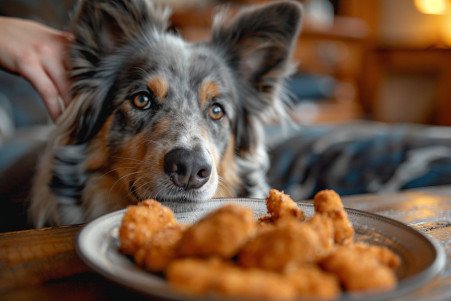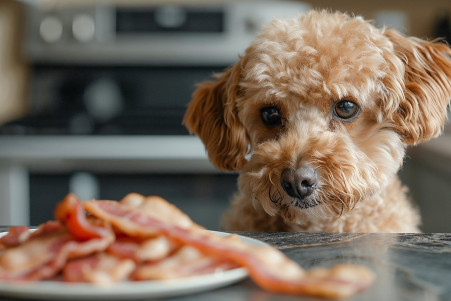Can Dogs Eat Chicken Skin? Risks and Safe Alternatives Explained
7 March 2024 • Updated 6 March 2024

If you’re cooking up a chicken dinner, you may be curious about whether or not it’s safe to share the chicken skin with your pup. You shouldn’t give your dog chicken skin as a treat because it’s high in fat and can lead to digestive issues and even pancreatitis. Instead, you can give your dog skinless, unseasoned, cooked chicken.
In this article, we’ll take a look at a variety of veterinary opinions and nutritional research to help you better understand the impact of chicken skin on your dog’s health. Our goal is to help you better understand the risks of certain foods, like fatty chicken skin, by looking at scientific research on dog nutrition and digestion.
We’ll cover what we find to help you better understand the risks and make healthier diet choices that will help keep your dog healthy.
Can dogs eat chicken skin?
Canine Digestive Complexity: Fat Digestion and Essential Fatty Acids
The canine digestive system is highly specialized for the digestion of dietary fats, which are an essential part of a dog’s diet. According to WikiVet, fat digestion begins in the stomach and requires the pancreas, gallbladder, and small intestine to work together.
The small intestine then absorbs the free fatty acids and glycerol that the digestive process has broken down from fats. This absorption is important for dogs, since not only are fats a major source of energy, but they are also needed for the absorption of fat-soluble vitamins, and for healthy skin and coat.
In addition, dogs require certain fatty acids in their diet, such as omega-6 and omega-3 fatty acids, because their bodies can’t make them. Essential fatty acids like linoleic acid and alpha-linolenic acid are important for metabolic and structural processes in the canine body.
The effect of different dietary lipids on a dog’s gut microbiome is also important. A study published in PMC found that the fat content of a dog’s diet is important because it can have a major impact on the microbial community in the dog’s feces.
In addition, not all fats are equally digestible, despite what many people believe. According to WikiVet, the digestibility of fats can be affected by the chain length of fatty acids and the presence of certain fibers. This is important to know when it comes to feeding dogs high-fat foods like chicken skin, which could potentially disrupt this balance and therefore have an effect on their health.
The Health Risks of High-Fat Diets in Dogs
In addition to being a high-fat food, feeding dogs chicken skin is a risky dietary choice that can lead to a number of health problems, including pancreatitis and obesity. Dogs are particularly prone to acute pancreatitis, which is characterized by vomiting, diarrhea, lethargy, and abdominal pain.
A study in PMC found that high-fat diets can induce or exacerbate the severity of pancreatitis in dogs. While clinical signs can be different, veterinarians often see elevated serum pancreatic lipase concentrations that can be associated with pancreatitis or other concurrent diseases, as noted in Animals, 2022, 12(12), 1581.
For example, chicken skin is high in fat, with a 3.5–ounce serving containing about 40 grams of fat, according to Health Digest. In comparison, a 3.5–ounce serving of skinless chicken breast contains only 1.24 grams of fat.
Veterinarians, as noted in the Journal of Veterinary Internal Medicine and Animals, recommend against feeding dogs high-fat foods due to the potential for health problems. Given the potential health risks of a high-fat diet, dog owners should look for other nutritional options to help their pets stay healthy and active.
Healthy Treats: A Nutritious Alternative to Chicken Skin
Instead of giving your dog fatty treats like chicken skin, there are many nutritious alternatives that can help supplement your dog’s diet. Raleigh Vet says that fruits like apples, blueberries, and watermelon can be a great way to add vitamins and antioxidants to your dog’s treat routine without the calories found in chicken skin.
Just make sure to remove any seeds and rinds to make sure that the fruit is safe for your dog to eat. Meanwhile, carrots and green beans can be a great low-calorie, crunchy treat that’s also high in fiber, according to PetMD.
Meanwhile, Tufts University’s veterinarians say that treats should be a small part of a dog’s diet, and they should make up no more than 10% of a dog’s daily caloric intake to help maintain a healthy weight.
Veterinary professionals recommend that you always introduce new foods to your dog’s diet in moderation. This means starting with small amounts to see if there are any gastrointestinal issues, according to Raleigh Vet.
Meanwhile, Purina says that lean meats like boiled chicken breast are a great source of protein that’s rich in omega fatty acids but doesn’t have the fat content found in the skin. Just make sure that the meat is cooked without any seasonings or bones.
Not only will these healthier options help you add variety to your dog’s diet, but they also follow the best practices for a balanced diet. This will help you set the stage for a diet that’s not only enjoyable for your dog but also supportive of their overall health in the long run.
How to Prepare Chicken Safely for Your Dog’s Diet
Preparing chicken safely for dogs is important to avoid any potential health risks. According to Recipes.net, it’s best to use boneless, skinless white meat, as it’s easier for dogs to digest and doesn’t pose the same choking hazards as bones. They also recommend using organic or free-range chicken for better quality.
When it comes to cooking the chicken, boiling, baking at 375°F for 20–25 minutes, and grilling over medium heat until the chicken reaches an internal temperature of 165°F are all safe options, as these methods will cook the chicken thoroughly without the need for potentially harmful seasonings. This is in line with the FDA’s requirements for pet food safety.
The American Kennel Club also stresses the importance of removing harmful seasonings and bones, and they say that unseasoned chicken is the healthiest option for a dog’s diet. As a pet owner, you should make sure to cook the chicken thoroughly, let it cool, and cut it into bite-sized pieces before giving it to your dog.
In addition to the FDA’s requirements, which are enforced by the Center for Veterinary Medicine, commercial dog food companies have to adhere to strict safety and nutritional guidelines, which can be a good standard to follow when you’re preparing food at home.
A healthy dog diet should include a mix of protein, vegetables, and carbohydrates, so chicken should be part of a varied diet. When you’re introducing chicken to your dog’s diet, start with small amounts and talk to a vet to make sure you’re meeting your dog’s specific dietary needs.
Final Thoughts on Giving Dogs Chicken Skin
In this article, we have shown that there is a general consensus among veterinarians that giving dogs chicken skin is not a good idea because of its high fat content and the health problems that come with it, including pancreatitis and obesity.
Experts from American Humane and Oakridge Animal Clinic have even gone so far as to say that the consequences of giving in to a pet’s begging and feeding them high-fat table scraps can be dire.
Part of being a good pet owner is making informed decisions about what we feed our dogs. As the veterinary professionals at PetMD and The Melrose Vet have said, it’s better to give dogs healthier treats like lean meats, as well as some fruits and vegetables, than it is to give them high-fat treats like chicken skin.
It’s important to remember that when it comes to a dog’s diet, it’s all about moderation and balance, especially when it comes to treats.
It’s important to talk to your vet regularly about your dog’s dietary needs. They can give you personalized recommendations that will help you make the best choices for your dog’s diet and ensure that they are as healthy as possible.
By making sure that we are feeding our dogs a balanced diet and being careful about the treats that we give them, we can make sure that they are as healthy and happy as possible.


